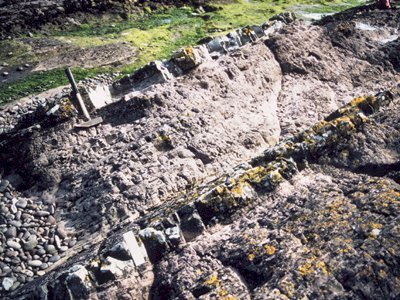Earth Science Conservation Review
| Port Obe, Cushendall | Antrim |

| Site Type: | Coastal section |
| Site Status: | ESCR |
| Council area: | Moyle District Council |
| Grid Reference: | D24702882 |
| Google maps: | 55.09125,-6.04686 |
| Rocks | |
|---|---|
| Rock Age: | Devonian (Lower Devonian) |
| Rock Name: | Ballyagan Formation, Cross Slieve Group, Cushendall Formation |
| Rock Type: | Conglomerate, Mudstone, Sand, Sandstone |
| Interest | |
| Other interest: | cross-bedding, dessication cracks |
Summary of site:
The rocks along the Antrim coast from Port Obe to Cushendun form the Cross Slieve Group are believed to be Devonian in age, somewhere between 350 and 400 million years old. The absence of fossils and other means of dating make this difficult to confirm but geological opinion supports this age. They are divided into three formations (see Key Site 1146 ‘Devonian - Cross Slieve Group; Cushendun to Port Obe'), the middle one being the Ballyagan Formation. Rocks on the shore at Port Obe are the best exposures of the formation.
Two steeply inclined ridges of an uncommon lilac to purplish-red sandstone, varying in grainsize from medium to coarse, protrude through the beach deposits. The top of each ridge is formed of a 15cm-thick bed of hard, pale green mudstone with large scale cracks, filled with sand from the bed above. This is typical of baked, cracked and curled mudstones hardened in intense heat and inundated with sediment washed over by the next torrential downpour.
About 50m to the east is a craggy outcrop of very coarse conglomerate with volcanic cobbles, the basal beds of the Cushendall Formation, defining the top of the underlying Ballyagan Formation.
The coarse, pink sandstone forming the cliffs on the north side of Port Obe are also part of the Ballyagan Formation and show large scale cross bedding.
This locality is the best development of the formation and consequently is of great importance, warranting designation and protection.
Two steeply inclined ridges of an uncommon lilac to purplish-red sandstone, varying in grainsize from medium to coarse, protrude through the beach deposits. The top of each ridge is formed of a 15cm-thick bed of hard, pale green mudstone with large scale cracks, filled with sand from the bed above. This is typical of baked, cracked and curled mudstones hardened in intense heat and inundated with sediment washed over by the next torrential downpour.
About 50m to the east is a craggy outcrop of very coarse conglomerate with volcanic cobbles, the basal beds of the Cushendall Formation, defining the top of the underlying Ballyagan Formation.
The coarse, pink sandstone forming the cliffs on the north side of Port Obe are also part of the Ballyagan Formation and show large scale cross bedding.
This locality is the best development of the formation and consequently is of great importance, warranting designation and protection.
| Enlander, I., Dempster, M. & Doughty, P., 2025. Port Obe, Cushendall, County Antrim, site summary. [In] Earth Science Conservation Review. https://www.habitas.org.uk/escr/summary.php?item=309. Accessed on 2025-04-03 |
| Previous Site | Next Site |


